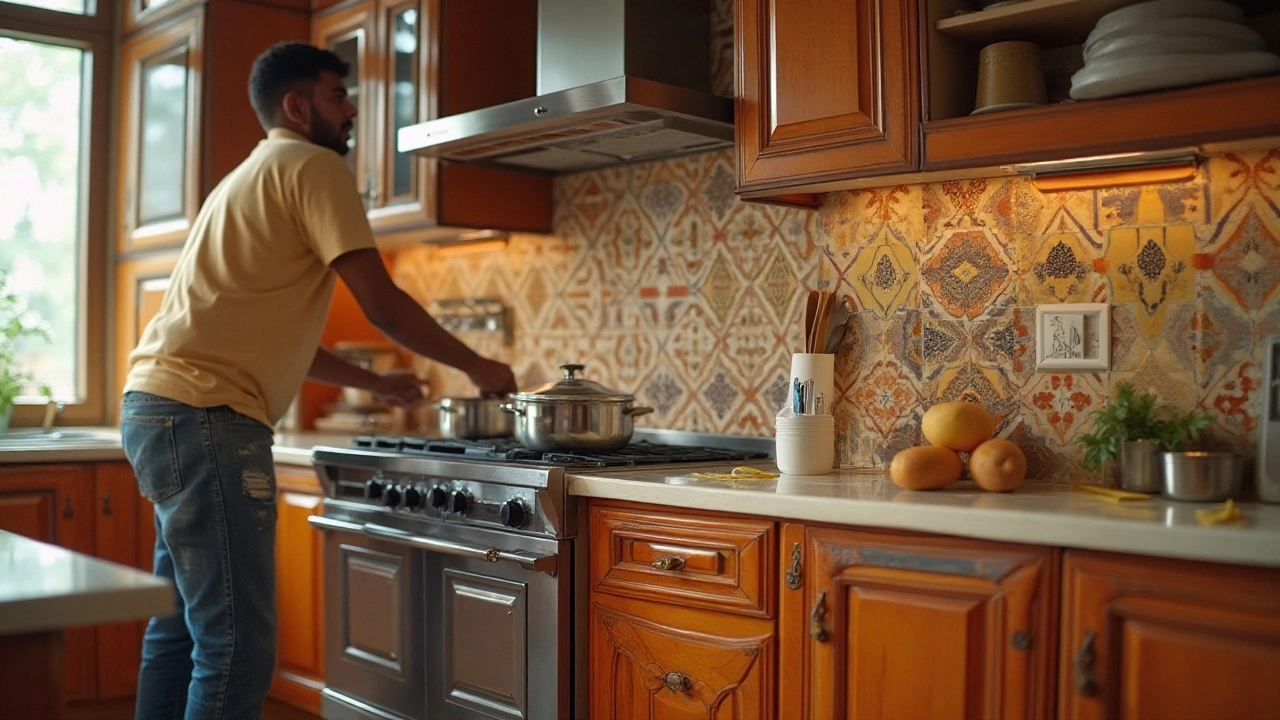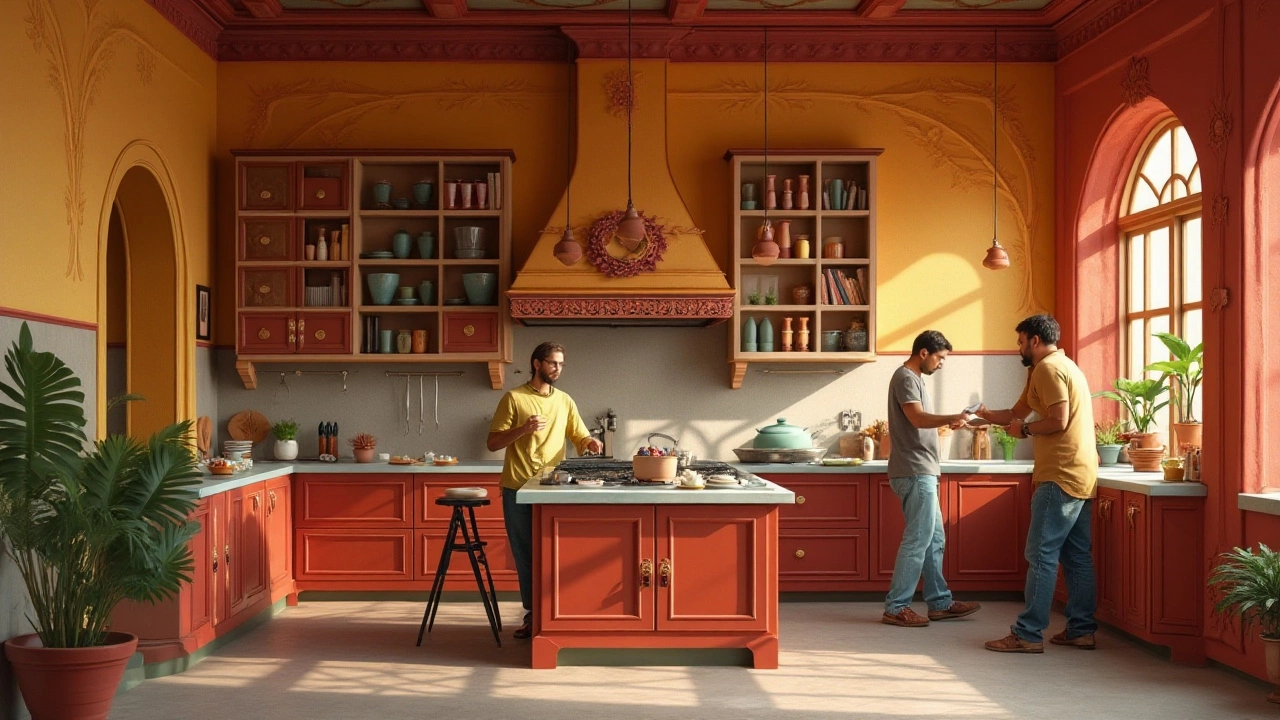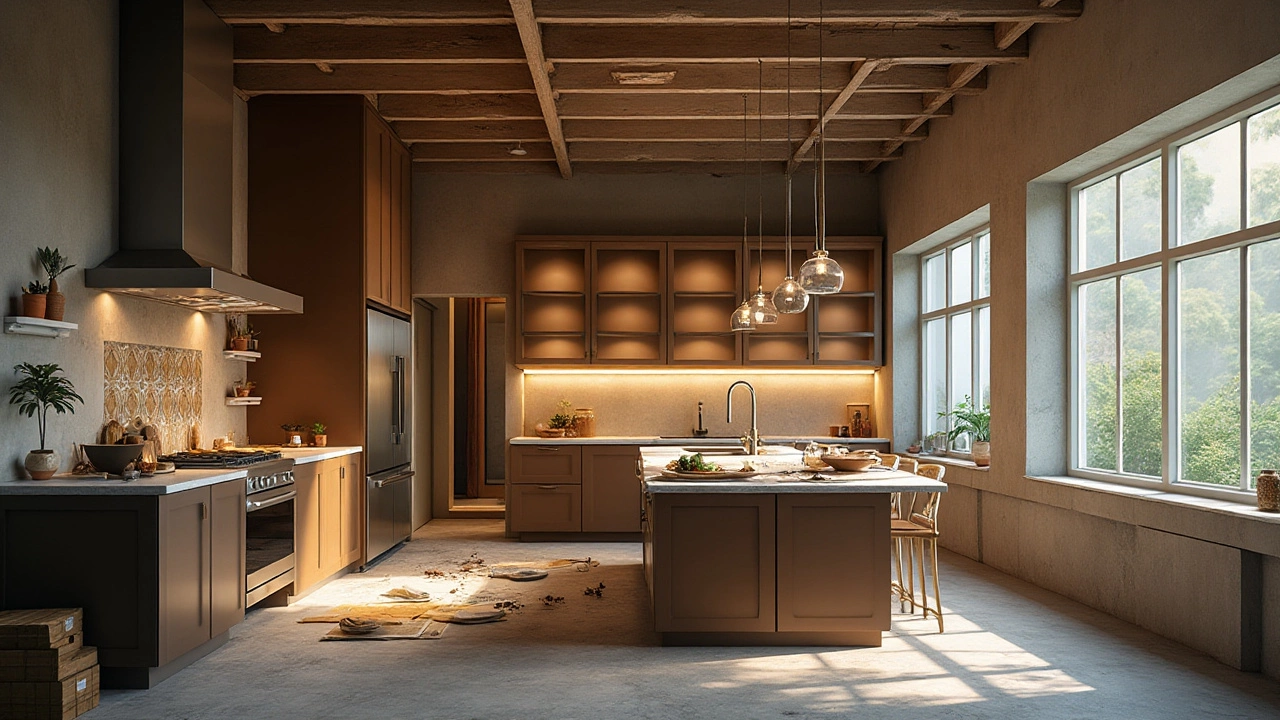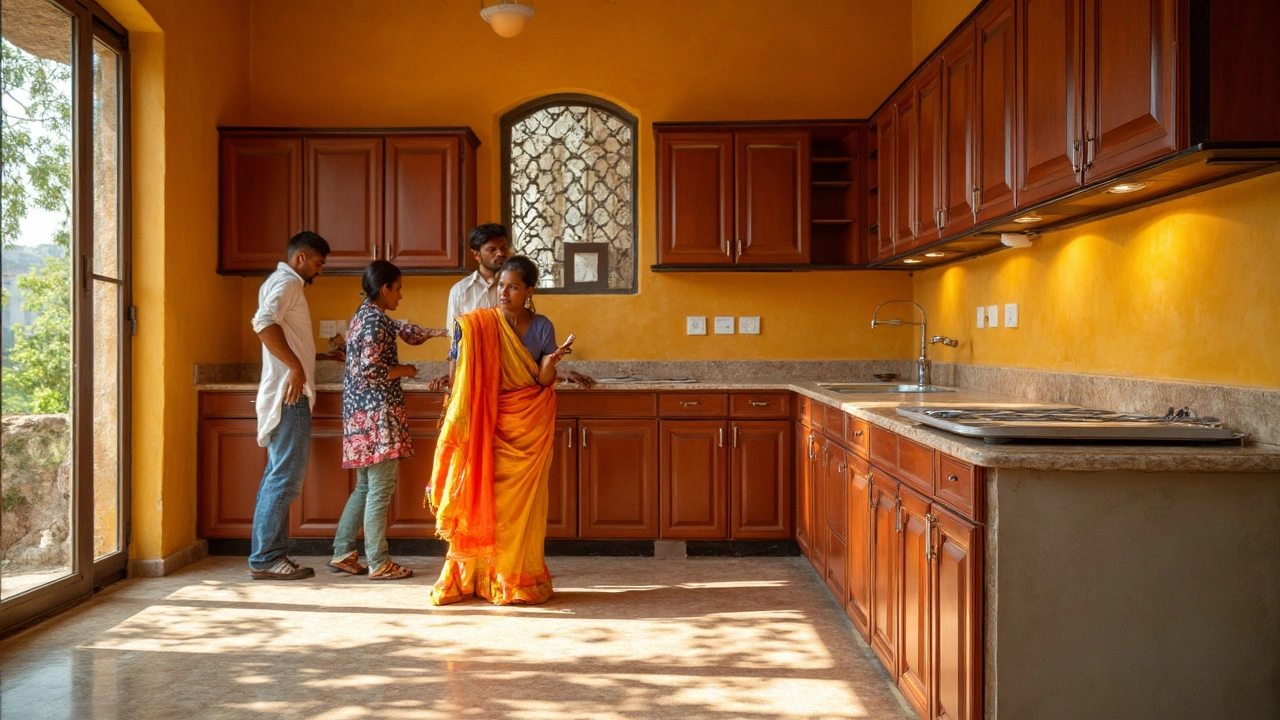Comprehensive Guide to Kitchen Installation Essentials

Kitchen installations are at the heart of turning a house into a home. They're not just about putting furniture in place but crafting spaces where meals and memories are made. A well-executed kitchen installation blends functionality with aesthetics, creating an environment that's both inviting and efficient.
Understanding the process and components involved ensures a smoother journey from concept to completion. Whether you're updating an outdated space or starting from scratch, knowing the key elements can make all the difference. Dive into the particulars of kitchen layouts, the importance of choosing quality materials, and the critical role of plumbing and electrical systems.
- Understanding Kitchen Layouts
- Essential Components of a Professional Installation
- Material Selection and Their Roles
- Navigating Plumbing and Electrical Requirements
- Finishing Touches: Lighting and Decorative Elements
Understanding Kitchen Layouts
A kitchen layout is more than just a map of where things go; it's the backbone of a functional kitchen that influences everything from cooking speed to safety. The most common layouts include the one-wall, galley, L-shaped, U-shaped, and the increasingly popular open-plan kitchen. Each design comes with its unique set of requirements and benefits, tailored to accommodate different space sizes and family needs. Understanding your kitchen's physical structure can help in squeezing out every ounce of potential from your space.
Let's start with the humble one-wall kitchen. This is typically found in smaller homes and studios. It aligns all the kitchen appliances and cabinets along a single wall, making it not just cost-effective but also space-savvy. It encourages vertical storage solutions, often requiring smart organizational skills to avoid clutter. The galley kitchen, on the other hand, features two parallel walls housing kitchen essentials. It's known for its economical use of space and is prized in professional kitchens for its efficiency. However, it can feel narrow, necessitating awareness of foot traffic and workflow safety.
The L-shaped kitchen layout offers a flexible design and positions the cook within a triangle of stove, sink, and refrigerator, which is an ergonomic boon. It's ideal for open spaces where the kitchen melds into the dining or living area. The U-shaped kitchen triples the L-shape's storage and counter space benefits but can become overwhelming in smaller homes. It's lavish in larger spaces, permitting multiple cooks to work simultaneously, fostering a communal atmosphere. Open-plan kitchens have erased boundaries between cooking and living areas, fostering social interaction but often demanding an integrated approach to design and decor.
"In most kitchens, a basic rule of thumb is that the total journey of the kitchen work triangle (stove, sink, fridge) should be no more than 26 feet, with each leg between 4 and 9 feet," as highlighted by principles of kitchen design.
With kitchen remodeling becoming more attuned to personal lifestyle and aesthetic aspirations, layouts need to support increasing demands for flexibility. Incorporating an island can bridge the gap in an open plan, offering extra workspace and storage, not to mention a spot for quick meals or putting finishing touches on appetizers at a party. Remember that choosing or modifying a layout should reflect not just the utility of the space but also the harmony it brings to the broader living area.
| Layout | Best For | Key Features |
|---|---|---|
| One-Wall | Small spaces | Simple, compact, minimal |
| Galley | Narrow spaces | Efficient, space-saving |
| L-Shaped | Expandable spaces | Flexible, social, ergonomic |
| U-Shaped | Large families | Spacious, ample storage |
| Open Plan | Social settings | Integrated, versatile |
Essential Components of a Professional Installation
Creating a beautiful and functional kitchen involves more than just a keen sense of style and some tools. It's about assembling a space where form meets function in the most efficient way possible. Let's take a deeper look into what truly makes a kitchen installation professional. To start with, understanding the kitchen's layout is crucial. Whether it's a galley, L-shaped, U-shaped, or island configuration, each serves different needs and maximizes space in unique ways. Tailoring the design to fit the household's lifestyle can greatly enhance daily efficiency. Take, for example, how the 'kitchen work triangle' concept—connecting the sink, refrigerator, and stove—helps in maintaining an effortless flow while cooking.
Another cornerstone is cabinetry. These are not just storage units, but key elements that set the aesthetic tone of the kitchen. Solid wood, laminates, or veneered composite materials each offer distinct advantages. High-quality hinges and drawer slides are essential for durability and ease of access. Experienced installers know that precise measurement is non-negotiable; even a few millimeters can make the difference between a good and exceptional fit. Cabinetry setup is also about optimizing storage capacity, not just installing pretty facades.
When it comes to surfaces, countertops are more than just a workbench; they are a statement. Choices range from granite to quartz, marble to laminate, each offering varied benefits in terms of durability and appearance. A professional installation ensures that seams are barely visible and that the surface is perfectly level to avoid the nuisance of rolling cans or cutting boards. Installation techniques are crucial here, with epoxy joining and proper sealing as basic requirements for extending the lifespan of these surfaces.
Integral to any kitchen installation is the meticulous sourcing and positioning of appliances. The excellence of a kitchen often hinges on smart choices here. Appliances should seamlessly blend with cabinetry and counter aesthetics while offering the latest technology for convenience and sustainability. Here, an emerging trend is the incorporation of smart appliances that allow for integration with home automation systems. But one shouldn’t overlook the simpler aspects either, such as ensuring all appliances are energy-efficient to keep the electricity bills manageable.
Attention must also be paid to the unseen heroes beneath it all—the plumbing and electrical systems. Each piping and wiring task calls for exacting standards and skilled expertise. Incorrect installation can result in costly mistakes and future water or electrical woes. It is essential to comply with safety codes and standards, which not only safeguard the home but also assure peace of mind. “Professionalism in home renovations is about upholding safety and quality above everything else. A well-executed plan mitigates future headaches,” said John Evans, a seasoned home builder, during a recent trade fair.
Furniture and lighting add the final touches. From seating arrangements that promote comfort and accessibility to lighting schemes tailored for both ambience and task-specific brightness, these elements refine the kitchen’s personality. Installing an adequate combination of ambient, task, and accent lighting creates layers that improve both beauty and utility. The advent of LED lighting technology has expanded possibilities in energy efficiency and design versatility. Every component, from drawers to dimmers, contributes towards making the kitchen not just a room, but a destination within a home.

Material Selection and Their Roles
The choice of materials in a kitchen installation is akin to picking the right ingredients for a recipe; both decisions shape the final outcome significantly. When it comes to creating a stunning and functional kitchen, the materials selected not only define the aesthetic but also crucially influence durability and maintenance needs. For those pondering a kitchen remodeling project, understanding the range of options—from the warmth of wood cabinetry to the sleekness of stainless steel appliances—is essential to achieving tailored results.
Cabinetry often forms the soul of the kitchen, and materials vary from cost-effective particle board to exotic hardwoods. While particle board might appeal for budget-conscious renovations, the timeless beauty and sturdy nature of maple or oak can offer unmatched longevity and elegance. Recent trends showcase an increasing proclivity for sustainable choices, with bamboo kitchens gaining popularity thanks to their eco-friendly qualities. Countertops, tasked with handling everything from chopping to serving, demand resilient surfaces. Quartz countertops, for example, meld the aesthetic appeal of stone with impressive durability, maintaining their shine without the need for sealing as demanded by natural stones like marble or granite.
As every culinary enthusiast knows, flooring sets the stage for both functionality and fashion. Ceramic tile remains a top choice for busy kitchens, offering easy cleanup and resistance to moisture. Yet, technological advancements mean that luxury vinyl now mimics the look of hardwood or stone while boasting water resistance and easier installation. Not to be overlooked, backsplash materials—such as glass tile or stainless steel—play dual roles: safeguarding walls from splashes and punctuating the kitchen's overall style.
On the topic of fixtures and fittings, consider the often-overlooked role of hardware. Drawer pulls and cabinet handles act as both functional elements and jewelry for your kitchen, with options ranging from traditional brass handles to sleek modern stainless ones. Finally, choosing the right sink and faucet materials, such as the enduring allure of ceramic or the modern edge of stainless steel, can influence both the room's utility and its stylistic direction.
In the words of interior design expert Tricia Guild,
"Materials speak a language all their own, telling a story of texture, color, and sensation that shapes how a space defines itself."This sentiment captures the profound impact that thoughtful material selection can have on the kitchen’s atmosphere, inviting thoughtful choices that encompass style and substance.
Navigating Plumbing and Electrical Requirements
Undertaking a kitchen installation project requires careful consideration of both plumbing and electrical components. These systems form the backbone of any kitchen, defining its functionality and safety. When it comes to plumbing, precision in piping layout can make a significant difference in both water delivery and waste disposal. It's crucial to ensure that the drainage system is installed with proper slope to prevent clogs and ensure efficient water flow. Additionally, selecting the right materials for plumbing, such as copper pipes known for their durability or PEX piping for flexibility, can impact longevity and maintenance needs.
Electrical work in kitchen installation is no less important. A well-designed electrical system should accommodate the plethora of modern appliances, from refrigerators and ovens to smaller devices like coffee makers and mixers. Ensuring adequate circuit loads and strategically placed outlets can prevent overloads and improve accessibility. According to the National Kitchen & Bath Association, the average kitchen contains roughly 6 to 8 circuits. Planning is key to create a safe and efficient electrical network. Incorporating energy-efficient lighting, like LED recessed lights, can dramatically alter the kitchen’s ambiance while being mindful of energy consumption.
Kitchen installation experts often stress the importance of adhering to local building codes and regulations, which vary by region but universally emphasize the need for safety and reliability. Whether it's ensuring GFCI protection in wet areas or adhering to amperage requirements, compliance is non-negotiable. For instance, the National Electrical Code requires GFCI protection for all 15 and 20-amp kitchen outlets. This reflects a wider commitment throughout the industry to ensure safety of use. Proper ventilation is also critical, not just for comfort, but to prevent moisture buildup and potential mold issues.
"The devil is in the details," notes renowned home improvement expert, Bob Vila, when discussing the nuances of kitchen plumbing and electrical setups. "An overlooked detail can lead to significant headaches down the line."
In planning these systems, homeowners and designers should also consider future needs and potential upgrades. Running extra conduit or leaving room for additional piping can make future renovations easier and more cost-effective. It’s also wise to consult with professionals who are experienced in kitchen installations to ensure all technical aspects are not only up to code but optimized for the kitchen's specific needs and layout. With technology advancing rapidly, some homeowners opt to incorporate smart home systems that allow for remote management of appliances and lighting. Embracing these innovations can enhance convenience and efficiency, but they demand a robust and thoughtful initial installation.

Finishing Touches: Lighting and Decorative Elements
When it comes to kitchen installation, the finishing touches can make or break the transformation from a functional room to a vibrant heart of the home. Lighting plays a crucial role not only in setting the mood but in ensuring the cooking and dining areas are practical and pleasant to navigate. Strategically placed lights can create different zones within a single space, highlighting key areas like the preparation bench, the dining nook, or even the chic cabinetry. Opting for a mix of ambient, task, and accent lighting can offer a dynamic yet cohesive look.
During the planning phase, consider how natural light enters your kitchen and how artificial lighting can complement those streams. Pendant lights over an island or dining table give off a cozy, warm presence, whereas under-cabinet lighting provides practical visibility for countertop tasks. An effective lighting scheme should prevent shadows while adding depth and character to the room. Experimenting with dimmable switches can offer flexibility, allowing the atmosphere to transition from bright and lively in the morning to soft and intimate by dinner time. As interior designer Jean Stoffer once advised,
"Lighting is a powerful tool to affect the mood and functionality of a space."
Decorative elements in a kitchen go beyond just aesthetics; they contribute to the atmosphere and can reflect personal taste. Consider using backsplashes as a canvas for creativity, whether it’s a bold tile pattern or a minimalist monochrome design. Cabinet hardware is another area where small details can create a big impact. Brass handles can evoke a classic elegance, while sleek, stainless steel can complement a modern setting. Think of your kitchen's decor as an extension of your style, incorporating elements like framed artwork, herb planters by the window, or a rustic clock that ties in with the cabinetry.
The choice of materials is significant as well. Blending different textures, such as wood and stone, adds layers of interest and warmth. Wooden beams or open shelving can soften the look of a sleek, contemporary kitchen, while metallic finishes might add a sense of modern luxury. Achieving the right balance requires thoughtful arrangement and a keen eye for detail. Remember, the best kitchens evoke a sense of warmth and are all about comfort where style meets functionality effortlessly. Ultimately, the combination of kitchen remodeling choices—whether they're lighting or decorative ones—should underscore your needs and dreams for the space, crafting an environment that delights every time you step in.

